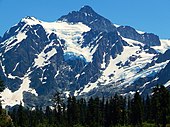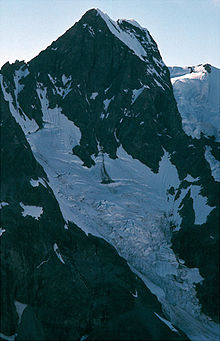A hanging glacier originates high on the wall of a glacial valley and descends only part of the way to the surface of the main glacier and abruptly stops, typically at a cliff.[1] Avalanching and icefalls are the mechanisms for ice and snow transfer to the valley floor below.[1]

Hanging glaciers are inherently unstable, and may produce catastrophic break-off events. These glaciers are often partially frozen to their bedrock, allowing them to locate on steep slopes. Break-off events leading to substantial ice avalanches pose severe hazards to humans, settlements, and infrastructure in alpine terrain worldwide.[2] Rock and icefall from a hanging glacier was responsible for triggering the Kolka-Karmadon rock ice slide in 2002, which killed 125 people.[3]

Formation
editHanging glaciers occur when a major valley glacier system retreats and thins, leaving the tributary glaciers in smaller valleys high above the shrunken central glacier surface. If the entire system has melted and disappeared, the empty high valleys are called hanging valleys.[4]
References
edit- ^ a b "Glossary of Glacier Terminology". United States Geological Survey.
- ^ Chmiel, Małgorzata; Walter, Fabian; Pralong, Antoine; Preiswerk, Lukas; Funk, Martin; Meier, Lorenz; Brenguier, Florent (2023-05-16). "Seismic Constraints on Damage Growth Within an Unstable Hanging Glacier". Geophysical Research Letters. 50 (9). Bibcode:2023GeoRL..5002007C. doi:10.1029/2022GL102007. hdl:20.500.11850/614371. ISSN 0094-8276.
- ^ Lindsey, Rebecca (9 September 2004). "Collapse of the Kolka Glacier". Earth Observatory. NASA.
- ^ "Science of Glaciers". National Snow and Ice Data Center. Retrieved 2024-09-26.